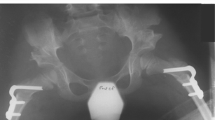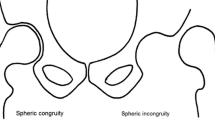Abstract
This article summarises a comparative retrospective study (1983–2001) of 42 consecutive spastic–diplegic ambulatory patients (aged 2–10 years) by examining the radiographic and clinical results of two soft-tissue procedures for paralytic hip subluxation (PSH). Group A comprised 20 patients (26 PSHs) who were treated by iliopsoas tenotomy, and group B comprised 22 patients (31 PSHs) who were treated by rectus femoris and iliopsoas tenotomy with iliac crest resection (sartorius release). All patients had bilateral adductor tenotomies. At 8.8 years mean follow-up, group A migration percentages (MP) improved from 39.8% to 24.7% with 92.3% good/average results. At a mean follow-up period of 8.3 years, group B improved from 58.0% to 25.9% with 96.8% good/average results. Long-term hip reduction was achieved in 84.6% of group A and 80.6% of group B hips. Relative MP correction was superior in group B. No patient had MP progression in either the PSH or non-PSH hip. Walking ability improved in 55% of group A and 86% of group B patients (Functional Mobility Scale). In conclusion, we recommend release of all the principle hip flexors: rectus femoris, sartorius, and iliopsoas, coupled with adductor tenotomies, in this patient group.
Résumé
Une comparative rétrospective de 42 patients diplégiques spatiques mais ambulatoirs âgés de 2 à 10 ans a été réalisée entre 1983 et 2001 avec évaluation des résultats. Deux techniques de libération tissulaire étant pratiquées devant l’existence d’une sub-luxation paralytique de la hanche. Le groupe A (20 patients, 26 hanches PSHs) ont été traités par ténotomie de l’iliopsoas, dans le groupe B 22 patients, 31 PSHs ont été traités par ténotomie du droit antérieur, de l’iliopsoas avec résection de la crête iliaque libérant le sartorius. Tous les patients ont bénéficié également d’une ténotomie bilatérale des adducteurs. À 8,8 ans de suivi, dans le groupe A, le pourcentage de migration de la tête MP est amélioré de 39,8% à 24,7% avec 92,3% de bons résultats en moyenne alors que dans le groupe B, à 8,3 ans la sub-luxation est améliorée de 58,0% à 25,9% avec 96,8% de bons résultats. La réduction de la hanche est obtenue dans 84,6% des cas du groupe A et 80,6% des cas du groupe B. La correction de la migration de la tête est supérieure dans le groupe B, aucun patient n’a vu sa migration augmenter. La marche a été améliorée de 55% dans le groupe A, à 86% dans le groupe B. Nous recommandons la libération de tous les muscles fléchisseurs de la hanche: droit antérieur, sartorius, iliopsoas en association avec une ténotomie des adducteurs chez ce type de patients.


Similar content being viewed by others
References
Barrie J, Galasco C (1996) Surgery for unstable hips in cerebral palsy. J Pediatr Orthop 5(4):225–331
Bleck E (1987) Orthopaedic management in cerebral palsy. Blackwell Scientific, Philadelphia
Bleck E (1990) Management of the lower extremities in children who have cerebral palsy. J Bone Joint Surg 72-A:140–144
Christoforo F, Taddonio R, Gelb R (1983) The effect of correction of spinal deformity and pelvic obliquity in hip stability in neuromuscular disease. Orthop Trans 7:557
Fabry G, McEwen G, Shands A (1973) Torsion of the femur. J Bone Joint Surg 55-A:1726–1738
Graham HK, Harvey A, Rodda J et al (2004) The Functional Mobility Scale (FMS). J Pediatr Orthop 24(5):514–520
Hodgkinson I, Berard C, Chotel F et al (2002) Pelvic obliquity and scoliosis in non-ambulatory patients with cerebral palsy: a descriptive study of 234 patients over 15 years of age. Rev Chir Orthop Reparatrice Appar Mot 88(4):337–341
Ingram AJ (1987) Paralytic disorders. In: Crenshaw AH (ed) Campbell’s operative orthopaedics, vol 4, 7th edn. C.V. Mosby, St Louis, pp 2987–2989
Kalen V, Bleck E (1985) Prevention of spastic paralytic dislocation of the hip. Develop Med Child Neurol 27:17–24
Michele AA (1962) Iliopsoas, 1st edn. Charles C. Thomas, Springfield, Illinois
Miller F, Cardoso Dias R et al (1997) Soft-tissue release for spastic hip subluxation in cerebral palsy. J Pediatr Orthop 17(5):571–584
Moreau M, Cook P, Ashton B (1995) Adductor and psoas release for subluxation of the hip in children with spastic cerebral palsy. J Pediatr Orthop 15(5):672–676
Palisano R, Rosenbaum P, Walter S et al (1997) Development and reliability of a system to classify gross motor function in children with cerebral palsy. Dev Med Child Neurol 39(4):214–223
Pap K, Kiss S, Vizkelety T et al (2005) Open adductor tenotomy in the prevention of hip subluxation in cerebral palsy. Int Orthop 29(1):18–20
Presedo A, Oh CW, Dabney KW et al (2005) Soft-tissue releases to treat hip subluxation in children with cerebral palsy. J Bone Joint Surg Am 87(4):832–841
Reimers J (1980) The stability of the hip in children. A radiological study of the results of muscle surgery in cerebral palsy. Acta Orthop Scand (Suppl) 134:1–97
Samilsion R, Tsou P, Aamoth G et al (1972) Dislocation and subluxation of the hip in cerebral palsy. J Bone Joint Surg 54-A:863–873
Sharrard W (1967) Paralytic deformity in the lower limb. J Bone Joint Surg 49-B:731–747
Spruit M, Fabry G (1997) Psoas and adductor release in children with cerebral palsy. Acta Orthop Belg 63(2):91–93
Turker RJ, Lee R (2000) Adductor tenotomies in children with quadriplegic cerebral palsy: longer term follow-up. J Pediatr Orthop 20(3):370–374
Vidal J, Deguillaume P, Vidal M (1985) The anatomy of the dysplastic hip in cerebral palsy related to prognosis and treatment. Int Orthop 9:105–110
Author information
Authors and Affiliations
Corresponding author
Additional information
No competing interests or funding declared in connection with this study.
Rights and permissions
About this article
Cite this article
Čobeljić, G., Bajin, Z., Lešić, A. et al. A radiographic and clinical comparison of two soft-tissue procedures for paralytic subluxation of the hip in cerebral palsy. International Orthopaedics (SICOT) 33, 503–508 (2009). https://doi.org/10.1007/s00264-007-0462-2
Received:
Revised:
Accepted:
Published:
Issue Date:
DOI: https://doi.org/10.1007/s00264-007-0462-2




